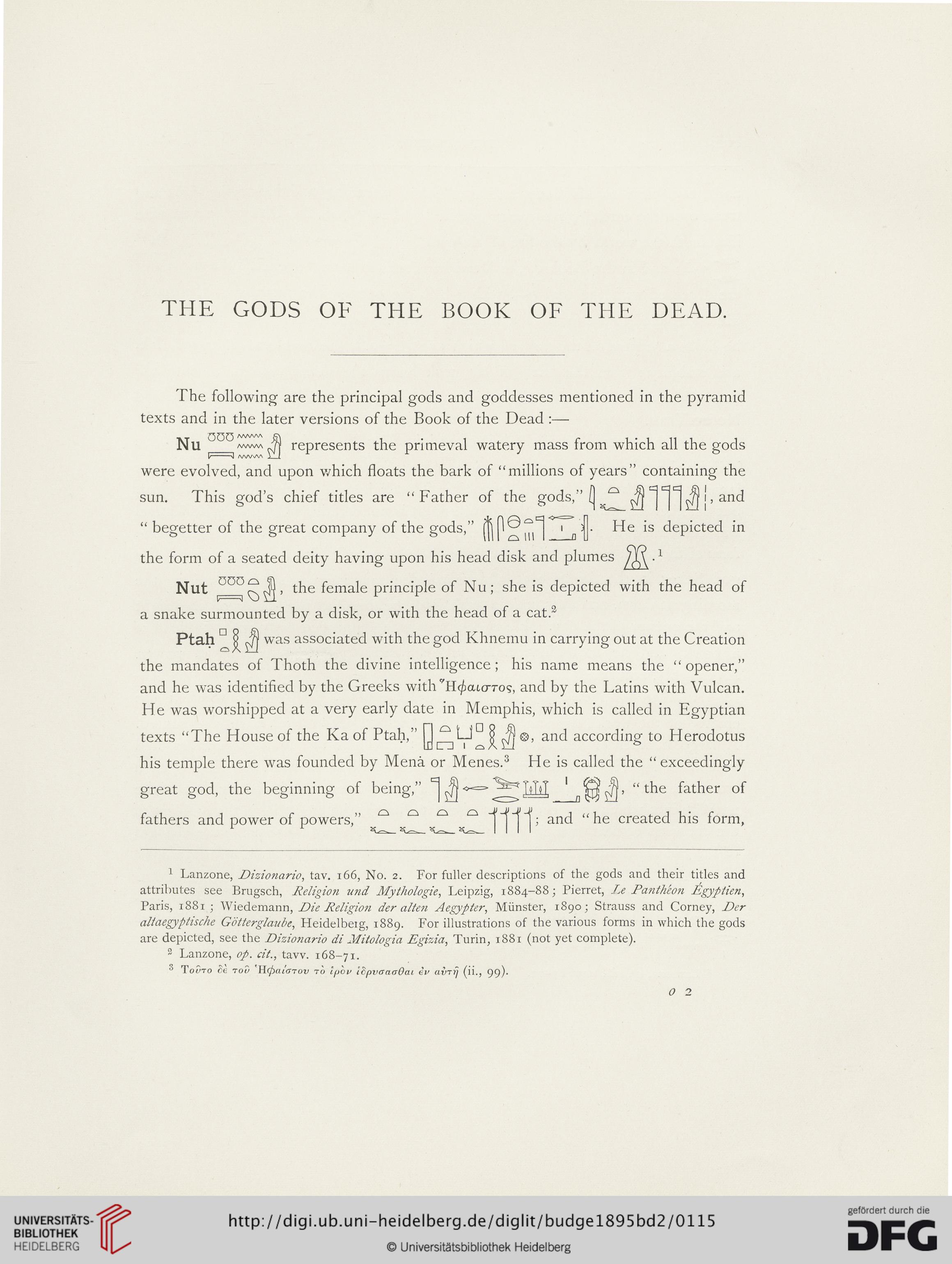THE GODS OF THE BOOK OF THE DEAD.
The following are the principal gods and goddesses mentioned in the pyramid
texts and in the later versions of the Book of the Dead :—
Nu oc represents the primeval watery mass from which all the gods
were evolved, and upon which floats the bark of “millions of years” containing the
sun. This god’s chief titles are “ Father of the gods,” (j
©
o iu
i:
kimii'and
He is depicted in
“ begetter of the great company of the gods,”
the form of a seated deity having upon his head disk and plumes
Nut ^ Jj, the female principle of Nu; she is depicted with the head of
a snake surmounted by a disk, or with the head of a cat.1 2
Ptah ° | was associated with the god Khnemu in carrying out at the Creation
the mandates of Thoth the divine intelligence; his name means the “ opener,”
and he was identified by the Greeks with''H^hucttos, and by the Latins with Vulcan.
He was worshipped at a very early date in Memphis, which is called in Egyptian
texts “The House of the Ka of Ptah,” ^ ©, and according to Herodotus
his temple there was founded by Mena or Menes.3 He is called the “exceedingly
great god, the beginning of being,” '"j <>*=- , “ the father of
fathers and power of powers,” ^ j; and “he created his form,
1 Lanzone, Dizionario, tav. 166, No. 2. For fuller descriptions of the gods and their titles and
attributes see Brugsch, Religion und Mythologie, Leipzig, 1884-88; Pierret, Le Pantheon iEgyptien,
Paris, 1881 ; Wiedemann, Die Religion der alten Aegypter, Miinster, 1890; Strauss and Corney, Der
altaegyptische Gdtterglaube, Heidelbeig, 1889. For illustrations of the various forms in which the gods
are depicted, see the Dizionario di Mitologia Egizia, Turin, 1881 (not yet complete).
3 Lanzone, op. cit., tavv. 168-71.
^ Touto 8e tou MfpaiOTOv to Ipov IbpvaaaOai eV uvtrj (ii., 99)*
0 2
The following are the principal gods and goddesses mentioned in the pyramid
texts and in the later versions of the Book of the Dead :—
Nu oc represents the primeval watery mass from which all the gods
were evolved, and upon which floats the bark of “millions of years” containing the
sun. This god’s chief titles are “ Father of the gods,” (j
©
o iu
i:
kimii'and
He is depicted in
“ begetter of the great company of the gods,”
the form of a seated deity having upon his head disk and plumes
Nut ^ Jj, the female principle of Nu; she is depicted with the head of
a snake surmounted by a disk, or with the head of a cat.1 2
Ptah ° | was associated with the god Khnemu in carrying out at the Creation
the mandates of Thoth the divine intelligence; his name means the “ opener,”
and he was identified by the Greeks with''H^hucttos, and by the Latins with Vulcan.
He was worshipped at a very early date in Memphis, which is called in Egyptian
texts “The House of the Ka of Ptah,” ^ ©, and according to Herodotus
his temple there was founded by Mena or Menes.3 He is called the “exceedingly
great god, the beginning of being,” '"j <>*=- , “ the father of
fathers and power of powers,” ^ j; and “he created his form,
1 Lanzone, Dizionario, tav. 166, No. 2. For fuller descriptions of the gods and their titles and
attributes see Brugsch, Religion und Mythologie, Leipzig, 1884-88; Pierret, Le Pantheon iEgyptien,
Paris, 1881 ; Wiedemann, Die Religion der alten Aegypter, Miinster, 1890; Strauss and Corney, Der
altaegyptische Gdtterglaube, Heidelbeig, 1889. For illustrations of the various forms in which the gods
are depicted, see the Dizionario di Mitologia Egizia, Turin, 1881 (not yet complete).
3 Lanzone, op. cit., tavv. 168-71.
^ Touto 8e tou MfpaiOTOv to Ipov IbpvaaaOai eV uvtrj (ii., 99)*
0 2





